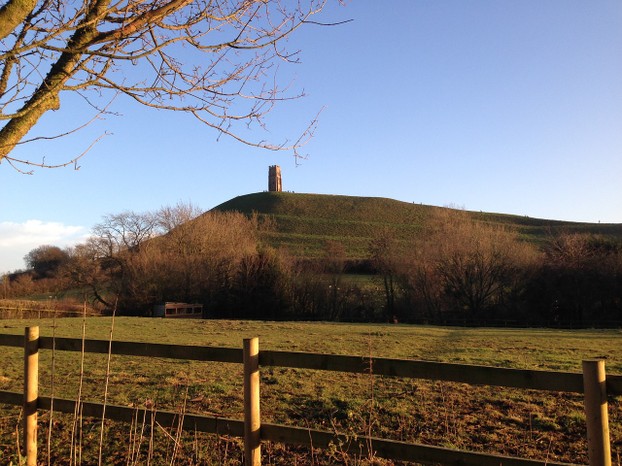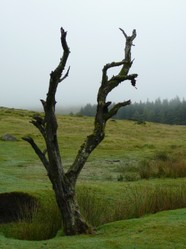Peter Owen-Jones is a vicar, a minister in the Church of England, the Anglican Church, a well-known author and television personality who has appeared on some high quality religious programmes in the UK, programmes that have taken him into encounters with people of many faiths and none. In this book he comes over as a man deeply hurt, and as he states near the end of the book that he returns to the bed that she no longer shares, we infer that he is coping with a marriage breakdown not of his choosing. At the end there is a hint that she left him for another man.
Walking was his therapy. He chose a route through England, beginning in Cornwall in the south-west and terminating twelve days later on the English side of the Scottish border and Cumbria. The distance between the walks was covered by car, which explains the short time required to journey this three hundred mile route.He travelled alone, in mourning maybe,staying at local inns and guest houses, always in bed by nine pm,for he had no social life to keep him up. Very sad!
Each chapter has the same format. It covers a short walk over one, maybe two hills. The author walked to the accompaniment of music, and each chapter begins with a recommended piece of music. All but one chapter has a map, and each one concludes with walking directions. Each chapter concludes with the total number of feet climbed.
This is not a book great on geographical facts. Rather it is rich in experiences, as the author observes people and land as he journeys. His work is reflective and well-written, and there is a touch of the poet in him.
But there is a touch of naivety at times. Writing of the top of Ashes Hollow on the Long Mynd in Shropshire, one of my favourite places, he notes the absence of corvids [crows and rooks] and says that it is as if the hunters have not found this valley yet. Sorry to tell you, Peter, but when my son Matthew and I walked that path more years ago than I would like to admit we espied a circling buzzard and heard its potential grouse victims a-churring in concealment in the heather, while the whinchats fled to cover! The hunters miss nothing.








 TheThousand Year Gardenon 11/26/2025
TheThousand Year Gardenon 11/26/2025
 Women of the Gospelson 10/11/2025
Women of the Gospelson 10/11/2025
 Religious Gardenson 08/25/2025
Religious Gardenson 08/25/2025
 Doctor of the Church: John Henry Newmanon 08/03/2025
Doctor of the Church: John Henry Newmanon 08/03/2025



Comments
Seven O'clock
Thank you for your comment below in answer to my previous observation and question.
The second paragraph to the first subheading, The author, designates a 9:00 p.m. bedtime the night before the particular day segment of the next walk.
What is the "rise-and-shine" get-up time?
The Cheviots would be too tough for my body. I will leave them to my son. I am 74,and it tells on me.
Thank you for your comment below in answer to my previous observation and question.
The article dates from the year 2019. So it was my hope that you'd managed to do the Cheviot walk later that very year.
Might this Cheviot challenge be something that one son or both sons might do?
No. Innthe intervening years I have been struggling with iĺllness
Your comment below in answering another reader's observations and questions alerts us to your not ascending Cheviot, as of June 25, 2019.
Did you arise to its challenge in the five-year interim since your answer?
If not, might your sons do so?
Thanks, Dustytoes. I like to write about paths that I have personally experienced, or at least read about in a book that I can review.
BSG, I have walked in all the areas where Owen Jones journeyed, bar Cheviot, though I have not done the exact walks that he did.
You can see more in such a book than most, having yourself had personal experience walking England, and probably much of the paths traversed. So when you share the details, except for his personal sadness, it is with deeper understanding, and can be relayed to your readers better than a professional book reviewer. This is of great value to those of us not in England, but keenly interested in England as a place of heritage. Thanks.
Walking in a beautiful landscape is a great comfort. As I read your review of the book, I kept thinking that you could do a nice job of writing about the history of favorite trails and landmarks.
Ashes Hollow is a narrow v shaped valley whose vegetation is mainly heather,gorse and coarse grasses. There are birds there, but mainly moorland birds. Only the grouse are hunted and then only in season. Most birds in Britain are protected from hunting, so their numbers have not been depleted by hunters.
There are many routes in Britain, but the pilgrim trail to Canterbury might be the most culturally significant. It is only about sixty miles. Recently the pilgrim trail to the revived shrine of Mary at Walsingham in Norfolk has grown in popularity.